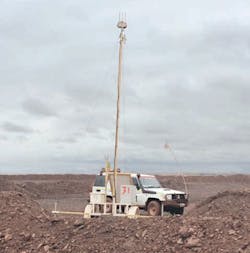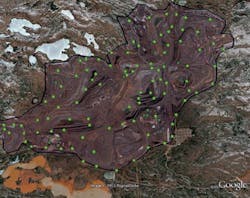Mining is a capital intensive business requiring expensive heavy equipment operating in some of the world's most hostile environments ➔ 1. The challenge is maximizing capital utilization by focusing the invested capital on revenue generating activities, ie, getting more of the best quality material from ground to port in the shortest time possible.
1 An open-pit mining excavator
Fleet management applications enable mine operators to achieve their capital utilization targets by orchestrating the dependencies between different pieces of equipment around the mine through real-time work order assignments to equipment operators. Combined with precision guidance systems, fleet management applications ensure that power shovels are getting the best quality material out of the ground and haul trucks know exactly where to take the material, minimizing wait times between operations. In addition, fleet management systems can also include real-time health monitoring of the equipment in order to improve equipment life-cycle costs and minimize downtime.
The importance of wireless networks in improving capital utilization cannot be emphasized enough. However, open-pit mines have some of the most challenging functional requirements for wireless networks. To begin with, for successful fleet management implementation, wireless networks must support mobility across the entire footprint of the open-pit mine and be reliable, scalable, flexible, secure and have multi-application capabilities. Mine fleets can vary in size from tens to hundreds of vehicles including haul trucks, power shovels, excavators, bulldozers, and drag-lines. Mobile coverage must be flexible enough to adapt to changing conditions and the topology of the open-pit mine.
Pits can shift in size and form requiring mobile coverage to adapt quickly and cost-effectively without extensive planning and implementation timelines.
The real-time nature of mission-critical fleet management applications requires low latency network support with less than 50 ms latency from the control room to the vehicle. In addition, open-pit mining requires reliable communications with minimal packet loss to ensure successful and real-time delivery of work orders to equipment across the mine. Multi-megabit broadband speeds are required for continuous equipment health, status and position monitoring, work order assignments, and operational safety video monitoring.
Security is another major concern for open-pit fleet management implementations especially when it comes to Denial- of-Service (DoS), eavesdropping, and man-in-the-middle attacks. These types of attacks, if executed successfully on the network, can disrupt information flow between the control room and field equipment creating costly downtime, which in some mining operations is measured in millions of dollars per hour.
ABB Tropos wireless mesh networks support fleet management applications in some of the most hostile open-pit mining environments. An advantage of ABB Tropos technology is its ability to uniquely support the requirements of open-pit-mine wireless networking.
An open-pit mining environment
Mobile coverage is one of the major issues in open-pit mines. The implementation of tower-based wireless technologies, such as point-to-multipoint and cellular architectures, is challenging in terms of planning and cost. Towers are built away from pit edges on permanent ground and these edges can shadow RF signals, making coverage difficult at the bottom of the pit. The solution is to construct multiple towers around the circumference of the pit. However, when the pit form shifts, additional towers must be deployed to cover new areas. This is a costly and very time consuming solution.
2 ABB's solar-powered Tropos router
The ABB Tropos wireless mesh technology greatly reduces the need for large towers and in some cases eliminates it altogether. Routers, deployed on trailers around the pit, "discover" each other automatically and provide ubiquitous coverage for the entire pit. When the pit topology changes due to new mine sites, the trailers are simply moved to new edges, creating coverage for mission- critical applications within minutes instead of the months needed for a tower- based design ➔ 2 – 3.
3 A sample mesh router placement for an open-pit mine
High network availability, ie, available for five nines (99.999 percent), is required to support mission-critical fleet management implementations. To meet this requirement, wireless networks must have a built-in redundancy mechanism to minimize the probability of transmission failures. With ABB's solution, high availability and reliability are achieved as Tropos routers operate in a mesh topology with multiple paths through the network, dynamic operating frequencies, multiple radios, and multiple retransmissions on every packet.
A mine is a dynamic mobile environment with vehicles and people requiring seamless mobility as they roam between access points in the network. Delays and packet loss due to roaming events are not well tolerated in this environment due to its mission-critical nature. Lost work orders can significantly delay operations and in some cases interrupt the flow, creating cascading delays across the mine. Most of the packet loss and delay typically occur prior to a handoff. To overcome this problem, predictive wireless routing algorithms such as the Tropos Predictive Wireless Routing Protocol (PWRP) significantly improve handoffs by identifying new paths through the network before current paths degrade. In addition, seamless mobility in the Tropos wireless network is achieved through make-before-break connectivity, which is available when Tropos mobile routers are used in vehicles. This soft-handoff capability creates a new path through the network while existing paths are still functional.
Securing communication networks
Cyber security attacks are a real concern for open-pit mines as mine operators increasingly use communication networks to monitor and control hundreds of automation devices in the field and large outdoor facilities. These field automation networks support a diverse set of mission- critical applications such as fleet management. In a typical mine network deployment architecture, the field equipment is connected to the local or remote control rooms using TCP/IP or serial communications. This setup creates the potential for cyber security attacks from the field to the control room or vice versa. Where security is implemented in a field area network is just as important as what is secured and how it is secured, and for maximum protection, security must be enabled at the edge of the network as well as at locations closer to the network's core.
In mining security, this can be achieved by bringing enterprise-class security to field area networks and by extending that security all the way to the edge. Enterprise security is a multilayer, multi-application security model, which provides in-depth-defense using a number of overlapping standards-based security mechanisms. These security mechanisms are layered one on top of the other and are intentionally overlapped to minimize the impact of failure in any one mechanism and reduce the probability of a security breach.
The key security functional requirements and corresponding mechanisms are:
- Network access control using 802.1x, MAC ACLs and 802.11i/ WPA2 with central RADIUS server authentication to ensure that people and devices accessing the network are explicitly authorized before sending data through the network.
- Network resource and end-point protection using firewalls that block unwanted and malicious traffic, restricting its propagation across the network.
- Secure end-to-end data traffic transmission with AES encryption using Virtual Private Networks (VPNs) to protect against eavesdropping and man-in-the-middle attacks.
- Traffic segmentation and prioritization to effectively run multiple applications over common infrastructure while ensuring high levels of priority for mission-critical applications and protecting against DoS attacks.
- Secure network configuration and management for flexible security policy management and enforcement across the network.
Tropos mesh router's unique distributed architecture makes it possible for such functionality to be implemented in each network element. When Tropos routers are deployed, the integrated security mechanisms are rolled out all the way to the edge and to each vehicle and device in the field, giving the network an active role in protecting field devices against cyber security attacks.
Thinking ahead
ABB Tropos wireless mesh networks not only solve today's operational challenges in open-pit mines, but also create longterm strategic value for customers. Today's fleet management applications form the foundation for autonomous operation in the future where driverless vehicles in the mine are orchestrated and controlled from a central control room. The highly reliable, scalable, multi-application mesh architecture enables mining customers to move from fleet management to fully autonomous operations with minimal incremental capital investment.
Roman Arutyunov
ABB Power Systems, Wireless Communication Networks
Sunnyvale, CA, United States
[email protected]





